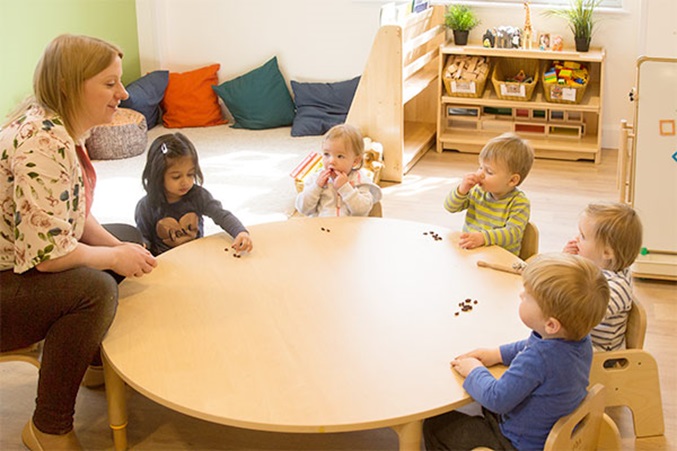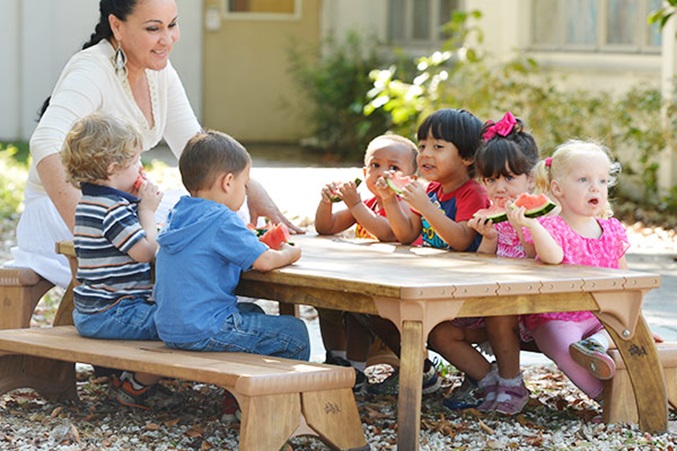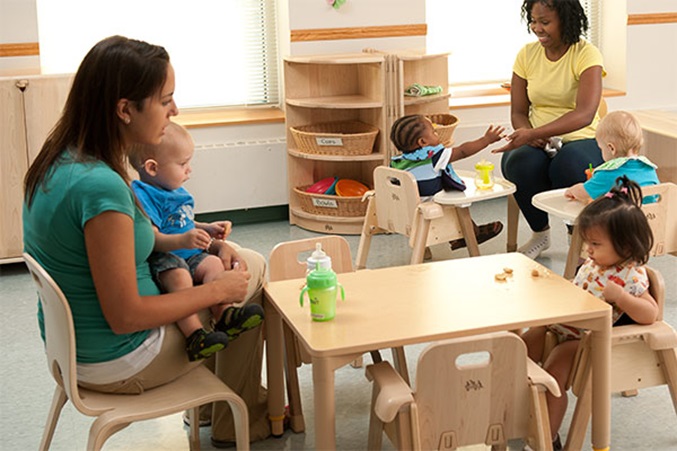Encouraging healthy eating habits for toddlers
The effect of diet on school performance
| November 2017This article is part of the series A model for living, focusing on eating, sleeping, playing and learning as main aspects of a child’s life.
“When a child is deprived of food, there is public outrage. And this is because child hunger is correctly identified as a moral and economic issue that moves people to action.” –Too Small To Fail, Clinton Foundation
Since the days of the first “hunter-gatherers” to Oliver Twist’s heart-stopping “Please, Sir, I want some more’’(Dickens 1838) moment and on into our present day western “Master Chef”-style revitalisation of the culinary arts, eating has been so much more than a basic, physical human survival need. One of the great societal dividers of our time, the act of eating and its immediate and long-term impact has provided politicians, scholars – and the rest of us – with absorbing and often contentious topics for discussion and social comment. Margaret McMillan, agitating for social change in the early 1900s when malnutrition was rife and conditions such as rickets (now frighteningly returning) were commonplace, declared the profound truth that it is “impossible to educate a …hungry child” (Mansbridge 1932). In doing so, McMillan unwittingly laid the foundations of “school readiness”.
Modern educators would not disagree with such a fundamental fact. Here we are in the 21st century, yet child hunger and poor nutritional standards remain a stark reality across many parts of the world. In the UK food banks proliferate as the austerity agenda bites, becoming an accepted social necessity for families struggling to provide food basics. Alongside this, medical evidence suggests childhood obesity is becoming a real national public health concern. Fewer families appear to value or have time for positive eating choices, behaviours and the associated social dimensions of eating together that are promoted by sharing family meals around a table. Too many children observe the daily routine of adults eating on the move from take-away bags, cartons and packets, as they scurry through their busy schedule or hurry on to their next appointment. Yet there is incredible potential in the simple act of sharing a family meal together. Family meals provide an opportunity to address the complex social components of eating behaviours (including limiting over-eating, making good choices and developing independent feeding skills) as small children mimic the eating choices, patterns and behaviours of others in the family. Schools and settings have an incredible opportunity to reinforce this by considering the important aspect of “social eating” and planning children’s snack and mealtimes with the positive impacts of calm, organised and interactive social engagement in mind. The social engagement structure of “family together” meal times can really help to shape a child’s eating behaviours and establish food preferences that can imprint positive patterns of eating for life.

Research into our food choices suggest we are increasingly subjected to the accelerating impact of a processed and over-varied diet. The increased purchasing of processed and convenience food choices is associated with:
- a pandemic of childhood obesity
- increases in infant dental caries
- physical and mental health problems
- poorer nutrition with less fresh fruit and vegetable choices
- increased sugar and salt intake
Over the last twenty-five years our tastes and food choices have changed. The basic four tastes of salt, sweet, sour and bitter have been joined by a hotly debated fifth, known as “umami,” a taste receptor that responds to many of the ingredients of over processed foods. Adults can easily become conflicted by the myriad choices of what children should eat. Clever marketing often leaves us pondering what came first, the “chicken nugget or the (needs of) the child!” At worst, adults make poor food choices for children from the standpoint of ease and convenience.
As a result, many children are not only at risk of future medical problems (e.g. diabetes mellitus, hypertension, orthopaedic problems, obstructive sleep patterns, low self-esteem, distorted body image [dismorphia], social stigmatisation), but also of becoming victims of consistently poor eating choices and even eating disorders. Such negative impacts can begin in early childhood and continue into school-age and adulthood. However, it is important to recognise that some perceived “unhealthy” choices can surprise us. Observing children in a nursery in China enjoying a morning snack of a square of deep fried “sticky rice” (where the entire school population maintain a healthy weight and processed foods are rarely, if ever, served), a matter of fact explanation changed the perception. The rice is locally grown without the use of pesticides or chemicals, the oil a vegetable based, unsaturated and purified version – and the treat served only once per week. Food for thought in all aspects!
However, there is little doubt that early childhood eating experiences affect both health and psychological well-being. Developing and supporting healthy eating patterns and habits in the first three years of life is crucial. This is when a small child’s eating abilities and needs change with motor, cognitive and social development. Research suggests that when parents allow children to determine timing, amount and pacing of a meal, this helps to develop self-regulation, relieve tension and promote a secure interest in food types and choices. Parental participation and example is instrumental in establishing and encouraging positive eating patterns in children. Preparing and eating healthy foods such as fruit and vegetables as a family has a positive effect on the consumption of those foods by children. But it is also true that if adults consistently model dieting for weight loss, this can result in issues related to regulating a child’s intake. These children are often referred to in the vernacular as “Muesli Belt” children, suffering forms of malnutrition resulting from consistently imposed low fat, low carb, low sugar diets in early childhood.

Adult eating disorders manifesting themselves in teenage or later life often have a basis in early childhood behaviours. There is a plethora of current research focusing on determining the precursors to such issues and the positive impact of educating parents and carers to embrace “healthy eating” for children from birth onwards. Many parents report that food times can often become battlefields with both child and adult using food (or the refusal of food) as a relational bargaining tool or manipulative weapon – “eat this for mummy”, “one more spoonful for daddy”, or the deeply damaging threats of certain foods being withheld until others are consumed.
It is interesting to note that many children are expected to eat when adults are hungry – bringing to mind Loris Malaguzzi’s poem, “The Hundred Languages of Children” from the book of the same title, where he purports that children are told by adults “to love and to marvel only at Easter and Christmas”, i.e. when adults decide! It is important that children learn at an early stage to recognise genuine hunger, respond to the feeling of having satisfied it, and to be at peace with the experience – a healthy eating habit for life. This requires a delicate and sensitive balance between the need to keep regular mealtimes whilst also encouraging self-regulation and sensible choices between meals!
The adverse impact of a nutritionally poor or restricted diet on children’s learning capacity and behaviour is well documented. Less widely reported is the growing bank of evidence around the negative long-term impact of a consistent diet of processed foods high in unhealthy fats, salt and sugars. In the next article of this series, we will explore children’s sleep, including how diet affects the quality of sleep and rest. If we are to achieve greater educational equality we must focus more holistically on the needs of the child across a wider range of domains than just the cognitive. For some time the most effective schools and early childhood settings have recognised the critical role they have to play in this “lifestyle for life” education, actively promoting children’s all-round “wellness” even though this adds an additional weight of responsibility on practitioners. The educational, health and social outcomes for their children suggest this is a wise investment with clear moral purpose.
This aspect of our “living model” adds to the increasing knowledge of the significant factors affecting children’s readiness to learn. In giving the widest consideration of children’s well-being and supporting the practical application of new understandings (some of which are simple truths and others, directly challenging questions), we can begin to gain a broader understanding of the nutritional and dietary needs and risks facing young children today. In our increasingly international society, we must also think inclusively about the diversity of cultural heritage that influences eating choices and behaviours in early childhood. Engagement with parents about food and mealtimes can provide first-hand understanding of cultural eating patterns, traditions and habits that can help us improve childhood nutrition and inform more appropriate eating programmes in all schools and settings.
We can also make a difference by asking challenging questions in our own schools and settings and acting directly on what we find out. For example:
- Why, even in the most “nutrition aware” schools and settings do children often experience the same “post-lunch slump” that causes adults in conferences to refer to it as “the graveyard slot” and practitioners to avoid offering core aspects of learning in the afternoon? In response, some schools are reducing the traditional carb-heavy lunch and seeing alertness and engagement levels accelerate post lunch.
- What about the “5 a Day” promotion that resulted in some children taking in far too much fructose with an associated increase in dental decay?
- What do parents really understand about the connection between eating together, nutrition, and learning capacity, and how can we help them?
- How can we support parents and children to navigate the minefield of appealing advertisements for “clever milk” and “vitamin water” and chocolate bars infused with protein, as the sophistication of consumer marketing strategies advances?
For schools and settings, the simplest questions can lead to useful professional discussion and make a genuine and impactful difference. The following examples may prove good starting points:
- What is the impact of sugar-laden breakfast cereals, breakfast biscuits and other “hidden sugars” consumed at this time on learning and behaviour? How much sugar do they actually contain?
- What about the impact on learning of having no breakfast at all?
- What times during the day are there any noticeable changes in children’s attention, motivation and focus? How can we find out if these are food-related?
- How do we know what children eat at home?
- What are children’s individual eating choices and behaviours in our school or setting?
- How do our arrangements for dining impact children’s eating behaviours and choices?
- What happens to children’s levels of attention and interest post-lunch? Every day? All children?
- What eating behaviours are we modelling as adults?
Researching and actively responding to the outcomes of such questions may inform your contextual “living model” of children’s future life chances far more than you can envisage or hope. At even the most basic level of awareness raising, such inquiry has potential to turn the tide and make the act of eating both a healthy and joyous experience for our youngest children. This may then help us to return to Oliver’s “key moment” and our shared refrain become: “Food, magical food, wonderful food, glorious food”! (Bart 1960)

References:
Bart, L. 1960. Oliver! (the musical)
Child Health Guide 2017
Clinton Foundation https://www.clintonfoundation.org
Dental Public Health Epidemiology Programme 2017
www.nwph.net/dentalhealth/201617Survey5yearoldchildren/ACCESS%20Guidance%
Dickens, C. 1838. Oliver Twist
Edwards, C. P., Gandini, L., & Forman, G. E. 2012. The hundred languages of children: The Reggio Emilia experience in transformation. Santa Barbara, Calif: Praeger.
Elsevier Nutrition https://www.journals.elsevier.com/nutrition-research
Mansbridge, A. 1932. Margaret McMillan, Prophet and Pioneer: Her Life and Work
Obesity Update 2017 - OECD.org
State of Child Health Report 2017 https://www.rcpch.ac.uk/state-of-child-health







